The Polyphemus Moth
(Antheraea polyphemus, Cramer, 1776)
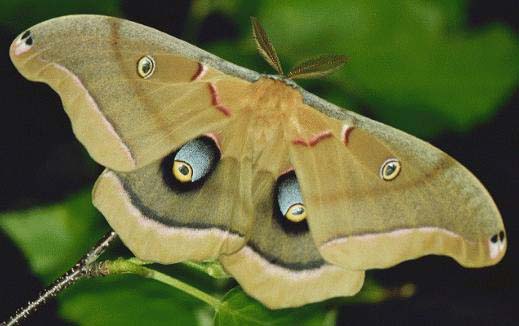
Male Polyphemus moth by Dan MacKinnon
This site has been created by
Bill Oehlke at oehlkew@islandtelecom.com
Comments, suggestions and/or additional information are welcomed by Bill.
Become a member of
THE WORLD's
LARGEST SATURNIIDAE SITE
Pictures, information, contests, prizes,
data base search engine, free cocoons, special member only privileges
TAXONOMY:
Superfamily: Bombycoidea, Latreille, 1802
Family: Saturniidae, Boisduval, [1837] 1834
Subfamily: Saturniinae, Boisduval, [1837] 1834
Tribe: Saturniini, Boisduval, [1837] 1834
Genus: Antheraea, Hubner, 1819
|
DISTRIBUTION:
The polyphemus moth (Antherea polyphemus) is North America's
most widely distributed large silkmoth (wingspan up to 6 inches). Native populations exist
in all U.S. states and Canadian provinces except Alaska, Arizona,
Hawaii, Nevada, and Newfoundland.
These moths are quite common here on Prince Edward Island,
Canada, despite being listed as absent from this province in "The Wild Silk Moths of North
America".
FLIGHT TIMES:
In Canada and U.S. border states
Antheraea polyphemus is univoltine (single brooded). Most adult moths fly from late May to July.
In New Jersey, the Ohio River Valley, and westward the species is
bivoltine (double brooded). Winter diapause stock (pupae that
have remained in cocoons over the winter) usually emerges in
April or May and second brood adults emerge in July or August.
In Texas and Florida adults fly in every month except
January.
On January 25, 2003, I received a report of a
pair of polyphemus in Florida. Adult moths were seen in the same area in late November.
Vernon Brou reports that there are five peak flights in Lousiana at 47 day intervals from mid-
March through September.
On January 30, 2003, I received a report of an outdoor
polyphemus emergence from Baton Rouge, Louisiana on January 29.
I suspect there is at least a partial sixth brood in La., or changes
in weather patterns are creating changes in flight seasons.
Fourth instar caterpillars experiencing sixteen hours of daylight/day
progress
directly from larvae to pupae to adult moths while those fourth instar
larvae that experience only twelve hours of daylight/day enter a pupal
diapause that will take them through the winter months. The diapause
will be broken by increasing hours of daylight and warmer temperatures.
Hence springtime weather conditions will determine whether there are one,
two, or three broods in a given year.
Males tend to emerge two to three days before females.
Here on P.E.I., Canada,
cocoons removed from cold storage (refrigerator crisper) in spring produce
adults in twenty-one to twenty-eight days when kept at room temperature
(24-25 C or 75-77 F).
ECLOSION:
The adults tend to eclose or emerge from
their cocoons in the early afternoon.
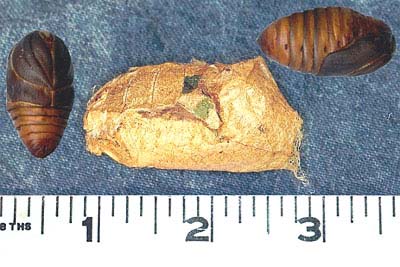
Photo by Dan MacKinnon with inserts from Kurt Himmelbauer. |
The adult secretes a
chemical called cocoonase to break down or soften the sericin
that binds the silk strands of the cocoon. Hornlike
projections at the base of the forewing are then used to tear
at the silk while strong legs continuously heave the
moth forward until it can escape from its valveless cocoon.
|
This event sometimes creates a racket in an indoor
emergence cage, but the process usually only lasts a few
minutes. The moth must now climb up the side of its emergence cage or
up a stem or tree trunk so that its wings can hang freely while
fluid is pumped into the numerous veins in the wings. After about twenty
minutes this "inflation" process is complete and the wings soon stiffen
in preparation for flight. Males tend to fly shortly after dusk. Females seldom
fly until after mating.
SCENTING AND MATING:
Females begin releasing their
pheromone, a 90:10 mixture of chemical attractant consisting of
6 cis-11-hexadecadienyl acetate and trans-6,
cis-11-hexacadienal aldehyde, at approximately 10:00 pm and continue scenting
until mating or around 1:00 am.
Unmated females scent again just before dawn.
The scent gland protrudes from the posterior end of the abdomen. |
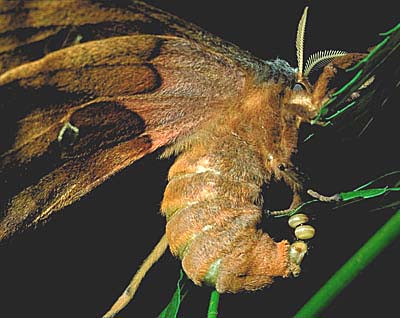
Photo courtesy of
David Wilbur. |
The same gland
is used to expel and affix sticky eggs to the undersides of leaves.
Flying males zigzag into the wind to locate the female scent plume with their highly developed antennae:
60,000 sensilla and 150,000 receptors.
The female moth pictured on the left has much smaller antennae
than the male to the right. The color differences are not
typical of gender, but merely of variations within the species.
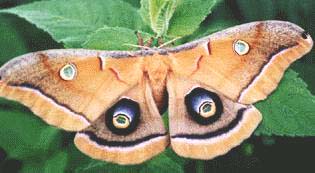
Photo courtesy of M. Whitmore. |
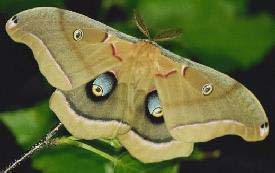
Photo courtesy of Dan MacKinnon
|
Males can only fly in temperatures above 7 C or 45 F and have been known to fly many miles in a single evening. Colder temperatures prevent the males from thermoregulating body temperatues by vibrating the wings.
This species mates readily in captivity, even in small cages
(one cubic foot) according to some texts, but I have not found this to be so on P.E.I.
Almost all of my matings occur when wild males fly in to my caged, scenting females. I seldom
get pairings with males in the cages.
Once paired, the couple tend to stay paired until
the following evening. A single mating will fertilize all of the
200-350 eggs. Males may mate again, but ova may not be viable. Sperm in the female receptacles
triggers ovulation responses, but even unmated females begin laying eggs after two or three
evenings.
OVA, LARVAE, COCOONS, AND PUPAE:
Relatively large, off-white ova with a brown band around the horizontal
circumference are laid singly or in groups of three to five on host plant leaves.
Incubation
lasts ten to fourteen days. Emerging caterpillars chew through one side of the the
egg. Photos by David Wilbur.
| 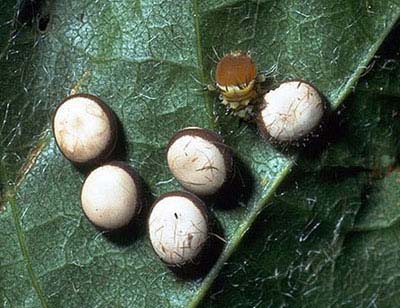 |
The larvae eat most of their eggshells and spend six to eight weeks
passing through five instars as green caterpillars.
The large brown heads, typical of
polyphemus larvae, are evident even in the first instar.
Larvae stop feeding and become
quiescent
for a day or two before shedding skins to make way for new growth. They should not be disturbed at this time. |
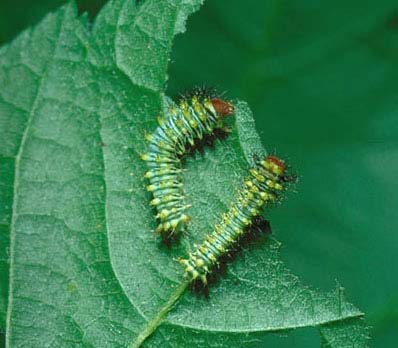 |
Relatively few larvae
fasten their cocoons to the tree branch with a peduncle, although this practice seems more common in southern latitudes.
In the north more larvae spin cocoons in a leaf wrap that will fall to the ground, or larvae
descend the tree to spin up in surrounding grasses. The larval gut is cleared via a loose, runny
stool just prior to the spinning of a compact oval cocoon. The
larvae secrete a substance that hardens the cocoon.
Pupae can be sexed by removing them from
cocoons. The outline of the antennae is clearly visible on the pupal
shell.
I usually don't remove pupae from cocoons.
If I want to sex them or check for disease or parasitization, I will
usually just use a sharp pair of scissors to cut a slit across
one of the longer axis. IT IS INTERESTING THAT PUPAE ORIENT THEMSELVES SO THAT THE
DORSAL SURFACE IS ALWAYS SKYWARD. IF THE COCOON IS ROTATED, THE PUPAE
WILL WIGGLE SO AS TO REORIENTATE THEMSELVES TOWARD THE LIGHT.
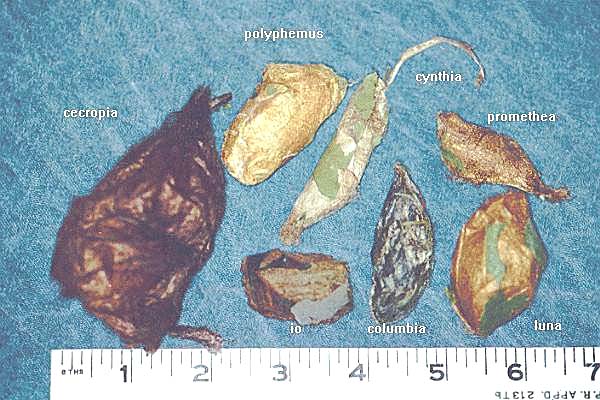
The silkmoths of the eastern U.S. and Canada have
very distinctive cocoons.
Click on caterpillar to see a large
image and access a listing of preferred and alternate foodplants.
Click on notes to access seasonal notes on A. Polyphemus.
Google lists at least one site for each of the following Saturniidae genera:
Actias, Adelocephala, Adeloneivaia, Adelowalkeria, Adetomeris, Agapema, Aglia, Anisota, Antheraea,
Antherina, Antistathmoptera, Archaeoattacus, Argema, Arsenura, Athletes (need species), Attacus, Aurivillius,
Automerella, Automerina, Automeris, Bunaea, Bunaeopsis, Caio (need species), Caligula (need species), Callosamia,
Catocephala, Cinabra, Cirina (need species), Citheronia, Citioica, Coloradia, Copaxa, Copiopteryx,
Coscinocera, Cricula, Decachorda, Dirphia, Dirphiopsis, Dryocampa, Dysdaemonia, Eacles,
Eochroa, Epiphora, Eriogyna, Eubergia, Eudyaria, Eupackardia, Eustera, Gamelia, Gonimbrasia,
Goodia, Graellsia, Gynanisa, Heliconisa, Hemileuca, Heniocha, Holocerina, Homoeopteryx,
Hyalophora, Hylesia, Hyperchiria, Imbrasia, Ithomisa, Lemaireia, Leucanella, Lobobunaea,
Loepa, Lonomia, ludia, Melanocera, Micragone, Molippa, Neoris, Nudaurelia, Oiticella,
Opodiphthera, Ormiscodes, Orthogonioptilium, Othorene, Paradirphia, Perisomena,
Periphoba, Polythysana, Procitheronia, Pselaphelia, Pseudaphelia, Pseudantheraea,
Pseudautomeris, Pseudimbrasia, Pseudobunaea, Pseudodirphia, Psilopygida, Ptiloscola,
Rhescynthis, Rhodinia, Rohaniella, Rothschildia, Salassa (need species: lola), Samia, Saturnia, Schausiella,
Syssphinx, Tagoropsis, Titaea, Urota, Usta (need species:terpsichore), Vegetia.
Visit other websites maintained by Bill Oehlke:
 | 
Show appreciation for this site by clicking on flashing butterfly to the left.
The link will take you to a page with links to many insect sites. |









